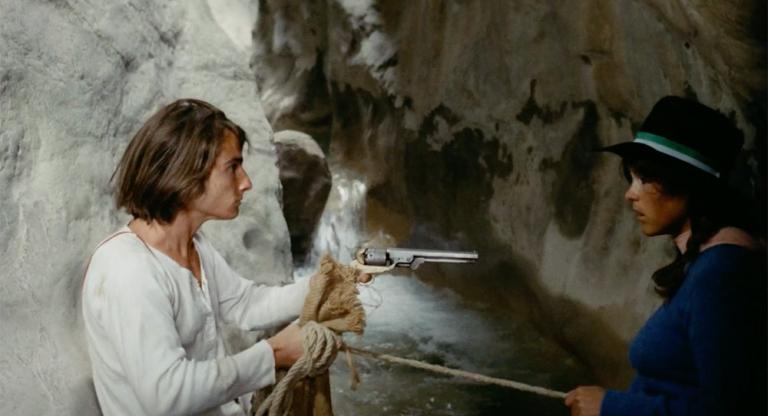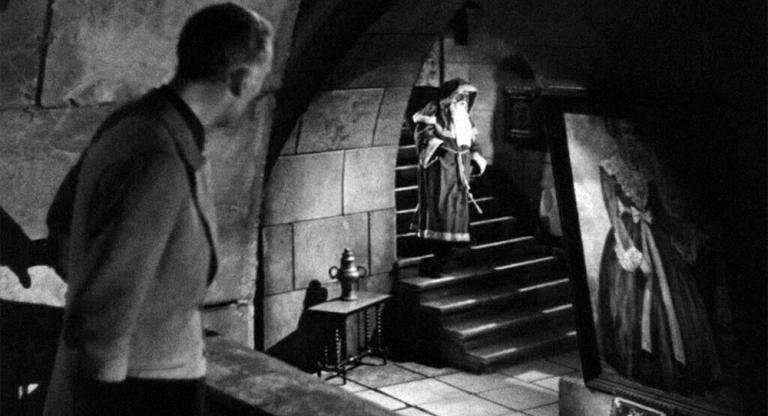Mikio Naruse’s third-to-last film opens with a handheld camera following Isao Tashiro (Keiju Kobayashi) as he walks down a sidewalk running alongside an arterial road in mid-60s Tokyo, past office towers and a Jaguar dealership. The day is gray, wet and windy; the neighborhood is ugly. He stops walking, looks back over his shoulder, directly into the camera, with the expression of a man hunted. This image of alienation and surveillance is of a piece with Naruse’s melodramas, which concern characters trapped by rigid gender roles, intense social scrutiny, and their own impossible desires. But The Stranger Within a Woman (1966)—a noir, more or less, with edgy modernist flourishes including stark Bergmanesque two-shots and solarization during violent scenes—gets at his familiar themes through uncharacteristic means.
Obviously shaken by events immediately preceding the start of the narrative, Tashiro retreats to a bar for a bowl of edamame, a big mug of Asahi, and an unbroken chain of cigarettes. There, he happens to run into Sugimoto (Tatsuya Mihashi), his neighbor and oldest friend. On the train home to the suburbs, Sugimoto, having been unable to reach his wife at her office, jokes that she must be with one of her boyfriends; Tashiro changes the subject. In fact, Sugimoto’s wife, Sayuri, has been murdered, and what follows is a film of suspense without mystery—less a whodunnit than a Hitchcockian study of a guilty conscience moving through the world. Prying eyes may uncover Tashiro’s sin at any moment; equally, they may be completely indifferent to it.
The queasy premise of the film’s source novel, The Thin Line, by the Lebanon-born, Oxford-educated Edward Atiyah, would seem to make it a more natural fit for Claude Chabrol, who adapted it into Just Before Nightfall (1971). But Naruse, working outside the “women’s picture,” finds ways to return to the preoccupations of his melodramas. Sayuri’s murder makes her and Sugimoto’s unconventional marriage a topic of gossip, fascination, and censure. Tashiro likewise feels the pressures of propriety bearing down on his own home life. Living with his mother and two small children, he is stricken with the typical salaryman’s neuroses—drinking too much and coming home too late, sleepless nights, an ulcer—and acts the part of the spectral postwar father, emotionally absent even when squiring his kids around an amusement park, and eventually retreating to a mountainside health resort, where his breakdown only accelerates following a fellow-guest’s suicide (from a bridge spanning a river gorge, Naruse zooms in on the body broken on the rocks below.) Tashiro’s anguish over the hypocrisy of his façade of normalcy, a kind of male hysteria, is surely a synecdoche for a larger social complicity. (Pick your poison: As Kobayashi was born in 1923, Tashiro is the right age to have fought in World War II, and to have enjoyed the fruits of Japan’s US-allied postwar economic miracle.)
As Tashiro’s wife Masako, Michiyo Aratama is given frontal close-ups that betray the director’s true sympathies, making her a classic Naruse heroine despite the film’s different gender and genre emphasis. She emotes desperately within a locked-off frame that stands in for larger constraints, making decisions increasingly driven by fear and a woman’s survival instinct. Given the humiliation and moral compromise to which her husband’s escalating, self-pitying confessions subject her, why does she stay? (Why does anyone?) Eventually conspiratorial, the marital relationship makes this film an oddly fitting companion to Juror #2 (2024): Here, it’s the wife who is capable of burying any evil deed, and rationalizing it as being for the greater purpose of family stability. Masako clings to her loveless marriage with an animal urgency—evidently, even this is preferable to the shame and suspicion that would attach to a woman alone.
Played in flashbacks by Akiko Wakabayashi, a Bond Girl in the following year’s You Only Live Twice, Sayuri cuts a striking, zeitgeisty figure with her jet-black mod haircut and kohl eyes. Wakabayashi is significantly younger than her costars—young enough to be untouched by the far. The echoes of Camus in the film’s title come from dialogue establishing Sayuri as an inscrutable Other within her domestic milieu—perhaps most notable in her taste for sexual choking. This element of the plot is startling in its frankness, but just one of the extremities Naruse explores in perhaps the most psychologically confrontational film of his career.
The Stranger Within a Woman screens on 35mm on Friday, December 12, at BAMPFA.
Previously:
The Stranger Within a Woman screens tonight, June 15, at Metrograph on 35mm as part of the series “Mikio Naruse: The World Betrays Us.” Filmmaker Dan Sallitt will introduce tonight’s screening.



